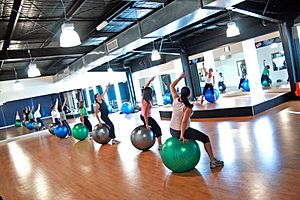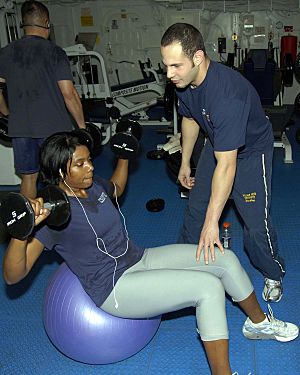Exercise ball facts for kids
An exercise ball is a big, soft, air-filled ball. It's made from a stretchy material called elastic. These balls usually measure about 35 to 85 centimeters (14 to 34 inches) across. You can make them firmer or softer by adding or removing air through a small valve.
People use exercise balls for many things. They are popular in physical therapy, which helps people recover from injuries. Athletes use them for athletic training, and many people use them for general exercise. You can even use them for weight training.
This useful ball has many names! While often called a Swiss ball, it's also known as a yoga ball, balance ball, fitness ball, gym ball, stability ball, or therapy ball.
Contents
Why Use an Exercise Ball?
Building Stronger Muscles
When you exercise on a soft, wobbly exercise ball instead of a hard floor, your body has to work harder. It needs to keep you balanced! This means many more muscles get involved. Over time, these muscles become stronger as they learn to keep you steady.
Focusing on Your Core
Most often, exercise ball workouts focus on your core muscles. These are the important muscles in your stomach (abs) and back. A strong core helps you with almost every movement you make.
Using an unstable surface like an exercise ball makes your muscles work harder without needing to lift heavier weights. For example, doing sit-ups or push-ups on an exercise ball really makes your core muscles fire up.
More Muscle Activity
When you do exercises like a curl-up on an exercise ball, your rectus abdominis muscles (your main stomach muscles) show more electrical activity. This means they are working more intensely compared to doing the same exercise on a flat, stable surface.
Even simple exercises like push-ups on an unstable ball can help strengthen your core. This can make your body more stable and even help prevent injuries.
Other Ways to Use an Exercise Ball
Exercise balls are not just for workouts! They can also be used for comfort and support in certain situations. For example, some people find sitting on a large plastic ball helpful for support during physical processes, like preparing for childbirth.
Sitting upright on the ball can help with body positioning and make someone feel more comfortable. Gently rocking the hips while sitting on the ball, with support from a bed or table, can also provide comfort and aid natural body movements.




